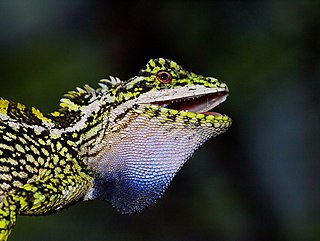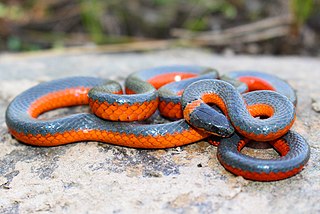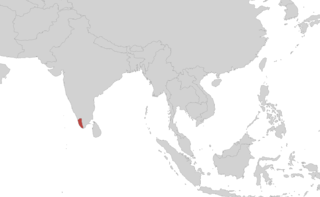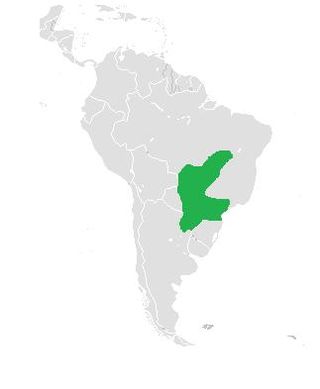
Caecilians are a group of limbless, vermiform (worm-shaped) or serpentine (snake-shaped) amphibians. They mostly live hidden in soil or in streambeds, and this cryptic lifestyle renders caecilians among the least familiar amphibians. Modern caecilians live in the tropics of South and Central America, Africa, and southern Asia. Caecilians feed on small subterranean creatures such as earthworms. The body is cylindrical and often darkly coloured, and the skull is bullet-shaped and strongly built. Caecilian heads have several unique adaptations, including fused cranial and jaw bones, a two-part system of jaw muscles, and a chemosensory tentacle in front of the eye. The skin is slimy and bears ringlike markings or grooves, which may contain tiny scales.

Plesiosaurus is a genus of extinct, large marine sauropterygian reptile that lived during the Early Jurassic. It is known by nearly complete skeletons from the Lias of England. It is distinguishable by its small head, long and slender neck, broad turtle-like body, a short tail, and two pairs of large, elongated paddles. It lends its name to the order Plesiosauria, of which it is an early, but fairly typical member. It contains only one species, the type, Plesiosaurus dolichodeirus. Other species once assigned to this genus, including P. brachypterygius, P. guilielmiimperatoris, and P. tournemirensis have been reassigned to new genera, such as Hydrorion, Seeleyosaurus and Occitanosaurus.

The variegated mountain lizard or Himalayan dragon is an agamid lizard found in northern India, Bhutan, and Nepal.

Diadophis punctatus, commonly known as the ring-necked snake or ringneck snake, is a harmless species of colubrid snake found throughout much of the United States, central Mexico, and south-eastern Canada. Ring-necked snakes are secretive, nocturnal snakes, so are rarely seen during the day time. They are best known for their unique defense posture of curling up their tails, exposing their bright red-orange posterior, ventral surface when threatened.

Ichthyophis beddomei is a species of caecilian in the family Ichthyophiidae. This species is distributed widely in the Western Ghats in southern India. The nominal species might be a composite of several cryptic species. It is also known as the yellow-striped caecilian, Beddome's caecilian, or Nilgherries caecilian.

Ichthyophis tricolor, the three-colored caecilian or Maddatorai caecilian, is an amphibian endemic to the Western Ghats, India. Its taxonomic status is unclear, including its relationship with Ichthyophis beddomei and the possibility of cryptic species.
Uraeotyphlus malabaricus is a species of caecilian in the family Ichthyophiidae. It is endemic to the Western Ghats of India and is known from its type locality, "Malabar" in Kerala, and from the Nilgiri mountains in Tamil Nadu. It is known with several common names: Malabar tailed caecilian, Nilgiris caecilian, Malabar caecilian, and white-lipped caecilian.

The viperine water snake or viperine snake is a semiaquatic, fish-eating natricine water snake. Despite its common names, it is not a member of the subfamily Viperinae. It was given its common names due to exhibiting a dorsal colour pattern that superficially resembles that of sympatric adder species. In comparison to other Natrix species its head is also somewhat wider and more distinct from the neck. Like most members of the Natricinae it possesses a venom gland on each side of the upper jaw that produces a mild venom that may play a role in swallowing or digestion. The gland is not associated with an enlarged specialized tooth and the venom as to be applied by chewing. The species usually does not bite as a mean of defense, and the effect of a bite would be harmless to humans.
Ichthyophis atricollaris, also known as the Long Bloee caecilian, is a species of caecilian in the family Ichthyophiidae. It is endemic to Sarawak, Borneo (Malaysia), and only known from its imprecise type locality, "Long Bloee, Boven Mahakkam, Borneo". The type series were collected during the Nieuwenhuis expedition to Borneo and were deposited at the Rijksmuseum van Natuurlijke Historie, Leiden.

The big-headed pantanal swamp turtle or pantanal swamp turtle is a species of turtle in the family Chelidae found in Brazil, Bolivia, Argentina, and Paraguay.
Dahl's toad-headed turtle is a medium-sized species of side-necked turle in the family Chelidae. This critically endangered freshwater turtle is endemic to northern Colombia, where it lives in small pools, streams, and swamps, but aestivates on land.

Vanderhaege's toad-headed turtle is a species of turtle in the family Chelidae. The species is endemic to South America.
The narrowbar swellshark is a rare species of catshark, and part of the family Scyliorhinidae, known only from two specimens collected near Flinders Reef off northeastern Australia. This species reaches at least 44.5 cm (17.5 in) in length, and has a stocky body with a short, broad head. It can be readily identified by its zebra-like dorsal color pattern of transverse brown bars on a yellowish background. Like other swellsharks, it can inflate its body as a defensive measure.
The speckled swellshark is a little-known species of catshark, and part of the family Scyliorhinidae, endemic to the waters off northwestern Australia. It occurs on the outer continental shelf and upper continental slope, at a depth of 150–455 m (492–1,493 ft). This species grows to 69 cm (27 in) long and has a stocky body and a short, broad, flattened head. As its common name suggests, its color pattern consists of many dark spots and white-spotted dark saddles and blotches on a light gray background. The juveniles are yellow with dark spots and lines, and a distinctive eyespot-like mark behind each eye. Like other swellsharks, this species can inflate itself as a defensive measure.

Gerobatrachus is an extinct genus of amphibamid temnospondyl that lived in the Early Permian, approximately 290 million years ago (Ma), in the area that is now Baylor County, Texas. When it was first described in 2008, Gerobatrachus was announced to be the closest relative of Batrachia, the group that includes modern frogs and salamanders. It possesses a mixture of characteristics from both groups, including a large frog-like head and a salamander-like tail. These features have led to it being dubbed a frogamander by the press. Some more recent studies place Gerobatrachus as the closest relative of Lissamphibia, the group that contains all modern amphibians including frogs, salamanders, and caecilians, or place modern amphibians far from Gerobatrachus within a group called Lepospondyli.
Cranial kinesis is the term for significant movement of skull bones relative to each other in addition to movement at the joint between the upper and lower jaw. It is usually taken to mean relative movement between the upper jaw and the braincase.
Ichthyophis nguyenorum is a species of caecilian in the family Ichthyophiidae. They were first found in Kon Plông District, Kon Tum Province, central Vietnam, in 2006, and formally described in 2012. The species is now also known from the Cat Tien National Park in Đồng Nai and Lâm Đồng provinces, southern Vietnam, and is presumed to occur more widely in suitable habitat in central and southern Vietnam as well as in eastern Cambodia.
Ichthyophis moustakius, the Manipur moustached caecilian, is a species of caecilian in the family Ichthyophiidae. It is endemic to Northeast India. This species exhibits broad lateral yellow stripes from the anterior part of its tail, along its mandibles, between its nares, as well as elsewhere. The animal can reach a length of 300 millimetres (12 in). Its head is somewhat U-shaped and fairly short; scales are absent on its collars. The species' name is derived from the Greek word moustakius, meaning "moustache", due to the yellow arched stripes it possesses.
Gymnotus choco, commonly known as the cuchillo, is an electric knifefish. G. choco is distinguished from its cogenerate species group by a color pattern possessing pale yellow bands oriented obliquely, wherein the interband margins are wavy or even irregular; one to three Y-shaped dark bands occur on its body's posterior section; and its pale bands do not extend above the fish's lateral line on its body's anterior two-thirds. G. choco is most similar to G. paraguensis from the Pantanal in Brazil and Paraguay. From the latter, it is distinguished by having a narrower mouth, a more cylindrical body, and a longer preanal distance.
Ichthyophis sendenyu, the Sendenyu striped ichthyophis, is a species of caecilian found in India. This species of Ichthyophis possesses broad and solid lateral yellow stripes from about the level of the posterior of its disc to its eye level on the upper jaw, while arched yellow stripes extend to its nares. Its length does not exceed 350 millimetres (14 in). Its head is U-shaped and short. Scales are present in anteriormost grooves, with five to eight rows placed posteriorly on its dorsum. It is named after Sendenyu village, Nagaland, where the species was first found.
Bhatta, G. 1998. A field guide to the caecilians of the Western Ghats, India. Journal of Biosciences, Vol. 23(1): 73-85











